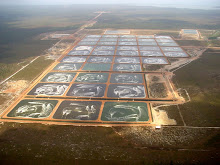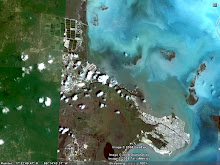Three agenda items here:
1. Meeting tomorrow at 11:35 at Uni High. I assume we're meeting at the usual spot.
2. We just passed 2000 hits on the Inventor's Club page. Our site has now been viewed in most states in the US, plus Canada, Mexico, Belize, Guatemala, Honduras, Costa Rica, Brazil, China, Germany, the Philippines, Thailand, Ecuador, Vietnam, Laos, Spain, India, Brunei, Malaysia, Singapore, the Cayman Islands, South Africa, Taiwan, Czechoslovakia, Turkey, Sweden, Finland and Iran. That's 28 countries so far.
Update, May 14th. 2122 hits and add Norway, Chile, Jamaica and Australia.
3. Newly acquired manufacturer information about AquaMats!
The following are facts gleaned from the Meridian Applied Technology Systems AquaMat Customer Information Manual (Nursery edition). We've already discussed much of this, but a summary may be useful here as we continue to think about our own substrates and scrapers.
AquaMats are especially recommended for nursery culture of shrimp from post larval stage 10 and up (approimately .01 to 2 grams of size). Sizes range from 2m X 1.22M to 2M X .61M. The Meridian Corporation reports up to 30% reductions in feed costs when AquaMats are used (a figure we may find useful for future calculations).
AquaMats require exposure to direct sunlight (as we have discussed).
AquaMats float. Therefore Meridian recommends that AquaMats be deployed on 2" PVC pipe frames sunk to the bottom and filled with sand. These are attached by cinching down by cable ties (those thin plastic strips used to bundle video cables).
Meridian also recommends that AquaMats be preconditioned prior to deployment. The desired colonizing organism (as we have discussed) is benthic diatoms. Diatoms are high in highly unsaturate fatty acids (HUFAs), an important nutritional item. Meridian discusses techniques that can be used to encourage the growth of specific desireable species. This is achieved by using pure cultures of these organisms and by saturating the mats in a solution of nitrate and phosphate salts (no lack of those in our sedimentation ponds) plus sodium metasilicate (silica is a limiting nutrient for diatoms) and some trace metals and vitamins.
Meridian recommends a 3 day culture time prior to introducing AquaMats as shrimp feed. This time period may vary with local conditions. As we discussed, if the mats are left in culture too long, they will acquire undesirable organisms. Each AquaMat user must determine the proper pre-conditioning time for their requirements.
Depending on the rates of algae growth and the density and growth rates of shrimp, algae films on AquaMats might continue to grow, become depleted or reach a steady-state where growth and removal become balanced.
Meridian states that AquaMats can be cleaned with a pressure hose and dried or simply returned to pre-condition tanks (effluent canals). Sterilization is generally not used, but can be used. The following sterilization methods are approved:
1. Steam sterilization @ 15 psi for 20 minutes.
2. 3% chlorate for 2 hours.
3. 10% Hydrochloric acid for 2 hours at 25 C
4. 30-50 ppm formalin for 1 hour
5. 3% acetoperoxide for 1 hour
6. Heating below 190 C
AquaMats are not recommended in systems with excessive fine clays. Secchi depths greater than 25 cm are required.
BARNACLES are a problem. Meridian recommends filtration of waters using Aquamats at 120 to 150 microns. We will have to address barnacle colonization (perhaps by scraping?).
Wednesday, April 22, 2009
Subscribe to:
Post Comments (Atom)




Alright, lots of new information!
ReplyDeleteThis is good, we can use this in our designing. Also is there any updates on the Independence high school? We just had a pizza sale and made some money, also we have been trying to find more local supporters in IL for what we are doing.
We did not get to meet last Friday, but this Friday we will, and we also will be getting some results from Lemelson-MIT grant. Is there anything we ought to specially discuss this week? I think that we need to come up with a time frame for when we should have a design and stuff. What do you think?
Hi Elizabeth.
ReplyDeleteThe group has done some great work this spring.
With the few weeks left of school your focus should be on bringing together the different aspects you have been discussing.
How does the scraper work with the surfaces you have been thinking about? How do you feel about the surfaces you have been using? Can you immediately think of upgrades?
I wouldn't obsess about getting a perfect design done this spring, but maybe a "rough draft" design that can be mulled over summer would be a good thing.
That way when you come back in the fall you'll be ready to offer constructive criticism, refine the design and go straight toward a prototype.